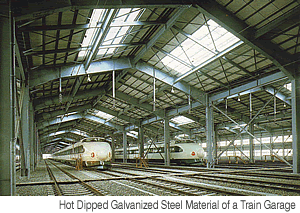#074 Corrosion Protection Measures - Metal Coating - 2
The most frequently used industrial plating for corrosion protection purpose are zinc (galvanizing) and tin plating. The zinc plating is used for corrosion protection of steels in natural environments such as air and water, and tin plating for the cans in the canning industry.
The zinc plating is the best known of plating less noble than steel. As shown in [Fig.1], this plating forms a cell with the steel being the positive and zinc being the sacrificial negative pole, protecting the steel from corroding. This is the same in principle as the sacrificial positive pole Corrosion protection scheme. The zinc plating film will eventually dissolve away and the steel will begin to corrode, therefore the corrosion resistance is proportional to the thickness of the zinc cell. This is in wide use as both hot dipped galvanizing and electroplating.
![[Fig.1] Sacrificial Positive Pole Principle of Zinc Plating [Fig.1] Sacrificial Positive Pole Principle of Zinc Plating](http://www.misumi-techcentral.com/tt/en/surface/images/074_1.gif)
The representative example of electro-zinc plated sheet steel is the Surface Treated Sheet Steel. It has precisely controlled thickness and excellent machinability, and often painted and used for automotive bodies, home appliances, equipment cabinetry, and construction material. For the automotive applications, zinc-nickel and zinc-iron alloy plating with further increased corrosion resistance are used.
|
Tin plating with pin holes and scratches in air and water forms a cell with the tin film being the positive pole since the tin is more noble than the steel, and does not offer the sacrificial Corrosion protection effects. It fares relatively well indoors but the same cannot be expected in environments where water contacts occur. However, the zinc would become of the negative pole when in contact with food and protects the steel from corroding in food canning applications. This is because the dissolved tin and certain elements from the food combine and form some complex compounds. Currently, steel sheets with plating film coated with highly anti-corrosive synthetic resin is used for food canning applications. |
 |
Hot dipping or thermal spraying must be used for aluminum plating since it cannot be electroplated. In water, aluminum plating is more noble compared to the steel base and a sacrificial Corrosion protective effect cannot be anticipated. Aluminum plating is typically used on high temperature applications such as stoves and chimneys as a heat resistant material.
- Environmental conservation
- Hot Dipping
- Anodic Oxidation Process
- Anodic oxidation treatment
- Anodizing
- Corrosion - Corrosion Protection
- Electroless Plating
- Electroplating
- Heat treating
- Hydrogen embrittlement
- Metal cleaning
- Metal etching
- Painting
- Special paints
- Surface Treatment
- Surface-treated steel sheets
- Thermal Spraying



